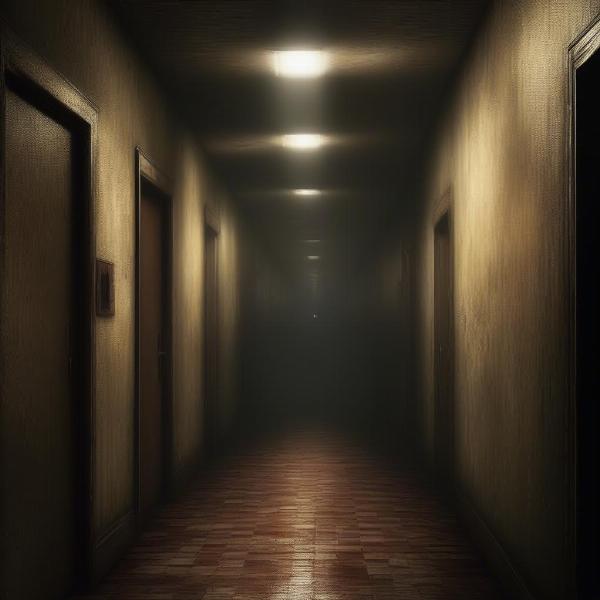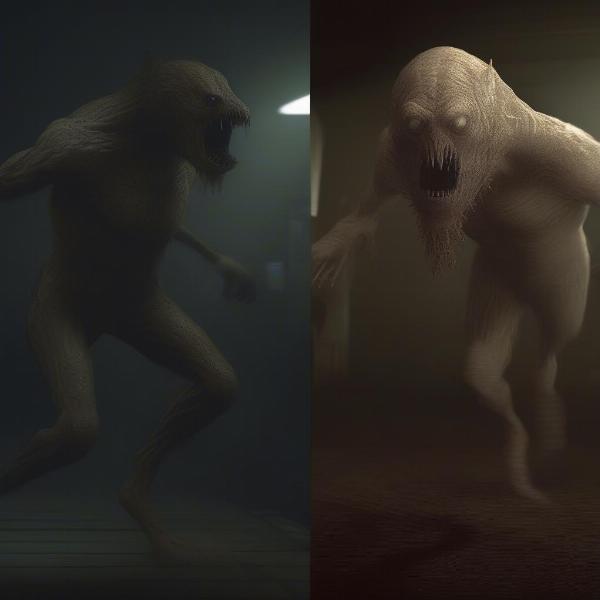The question of “What Is The Scariest Game Of All Time” is subjective and sparks endless debate amongst horror gaming enthusiasts. Fear is a personal experience, influenced by individual vulnerabilities and preferences. However, certain games consistently rise to the top of the list, leveraging psychological horror, jump scares, and disturbing imagery to create truly terrifying experiences. Let’s delve into the contenders and explore what makes a game truly scary.
Psychological Horror: Messing with Your Mind
Some games rely less on gore and more on psychological manipulation. These games often feature unsettling atmospheres, mind-bending narratives, and disturbing themes that burrow deep into your psyche. Silent Hill 2, for example, masterfully uses fog-laden environments and grotesque creature designs to represent the protagonist’s inner turmoil, making it a chilling exploration of guilt and grief. Similarly, Frictional Games’ Amnesia: The Dark Descent preys on the player’s helplessness, forcing them to hide from unseen horrors in the dark, creating a constant sense of dread and paranoia.
These games excel at creating a slow-burn fear that lingers long after you’ve put down the controller. They challenge your perceptions of reality and leave you questioning your own sanity. What is truly scary isn’t always what you see, but what you think you see.
 Psychological Horror Games: Exploring the Mind's Darkest Corners
Psychological Horror Games: Exploring the Mind's Darkest Corners
Jump Scares: The Art of the Startle
While often criticized for being cheap thrills, jump scares can be incredibly effective when used sparingly and strategically. Games like Five Nights at Freddy’s and Outlast utilize jump scares to punctuate moments of tension, jolting the player and creating a visceral fear response. These games often rely on building suspense through sound design and limited visibility, making the eventual jump scare all the more impactful.
However, overuse of jump scares can lead to desensitization and predictability. The most effective horror games use them judiciously, combining them with other techniques to create a more layered and terrifying experience.
What makes a jump scare effective? The element of surprise, coupled with a disturbing visual or sound, triggers a primal fear response.
 Effective Jump Scares: Mastering the Art of the Startle
Effective Jump Scares: Mastering the Art of the Startle
Cosmic Horror and the Unknown
Another subgenre that consistently delivers scares is cosmic horror. Games like Bloodborne and SOMA delve into the terrifying vastness of the unknown, presenting creatures and concepts that defy human comprehension. The sheer scale and incomprehensibility of these cosmic entities create a sense of existential dread and insignificance.
These games often explore themes of body horror and the fragility of the human mind when confronted with the truly alien. The fear they evoke is not just of physical harm, but of losing one’s sense of self and place in the universe.
What is scarier than the unknown? Cosmic horror games tap into this primal fear, forcing players to confront the limits of their understanding and the terrifying reality of a universe far larger and more complex than they can grasp.
What Makes a Game Truly Scary: The Expert’s Opinion
Dr. Emily Carter, a psychologist specializing in the impact of media on the human psyche, weighs in on the topic: “Fear in video games isn’t just about jump scares or gore. It’s about creating a sense of vulnerability and helplessness, disrupting the player’s sense of control. The most effective horror games tap into our deepest anxieties and fears, forcing us to confront our own mortality and the unknown.”
Another expert, game designer and horror aficionado, Mark Johnson, adds, “A truly scary game is one that stays with you long after you’ve stopped playing. It’s the lingering unease, the nightmares, the subtle changes in your perception of the world around you. That’s the mark of true horror.”
Beyond Jump Scares: The Future of Horror Gaming
The future of horror gaming lies in pushing the boundaries of psychological manipulation and immersion. Virtual Reality (VR) offers unprecedented opportunities to create truly terrifying experiences by blurring the lines between the virtual and the real. Imagine being trapped in a haunted house, feeling the cold breath of a ghostly presence on your neck, or hearing whispers in your ear. VR has the potential to elevate horror gaming to a whole new level of immersion and terror.
Is Silent Hill the Scariest Game Series?
The Silent Hill series has consistently been praised for its psychological horror elements. From the unsettling atmosphere of the fog-filled town to the grotesque creature designs, the games tap into deep-seated fears and anxieties.
What is the Scariest Game on PS5?
The PlayStation 5 boasts several terrifying titles, including the remake of Resident Evil 2 and the visceral horror of The Callisto Protocol. The choice ultimately depends on individual preferences.
What is the Scariest Horror Game on Roblox?
Even Roblox has its share of scary games. Titles like Piggy and The Mimic offer jump scares and creepy atmospheres that can be surprisingly effective.
Conclusion
So, what is the scariest game of all time? The answer is subjective and depends on individual fears and preferences. However, by exploring the elements of psychological horror, effective use of jump scares, and the terrifying unknown, we can begin to understand what makes a game truly chilling and memorable. While the debate continues, one thing is certain: the quest for the ultimate scare will continue to drive innovation and push the boundaries of horror gaming. What do you think is the scariest game? Let us know in the comments!

